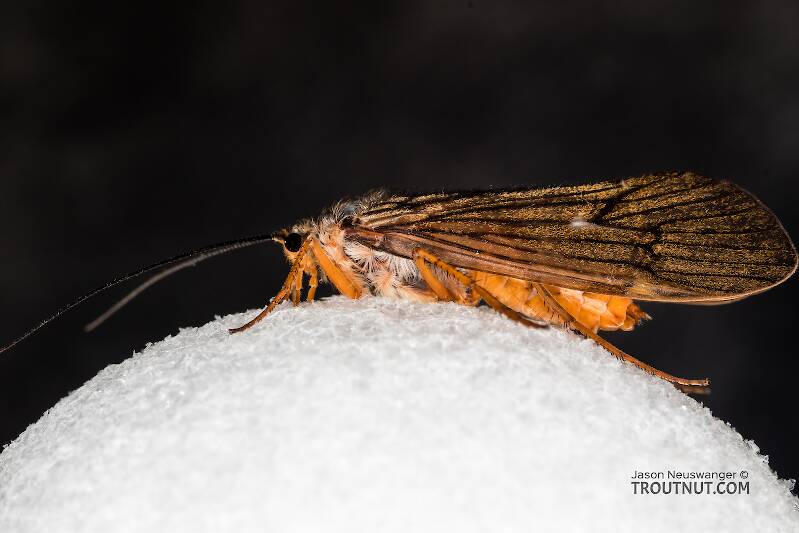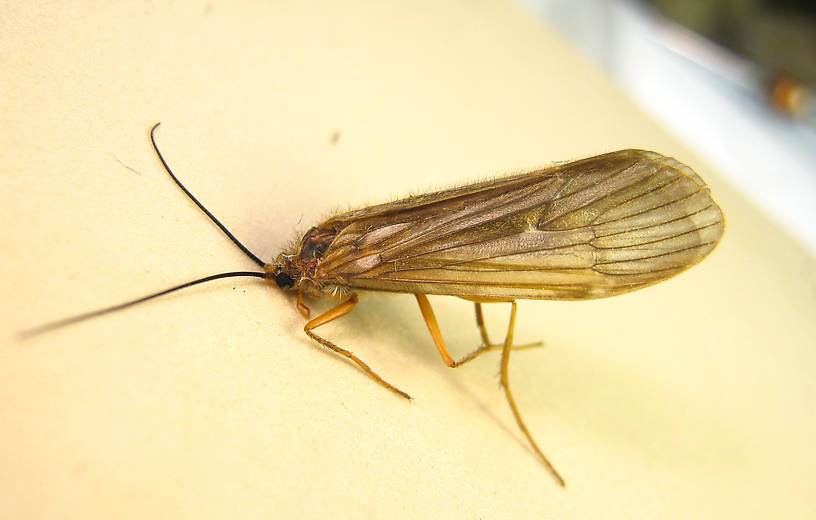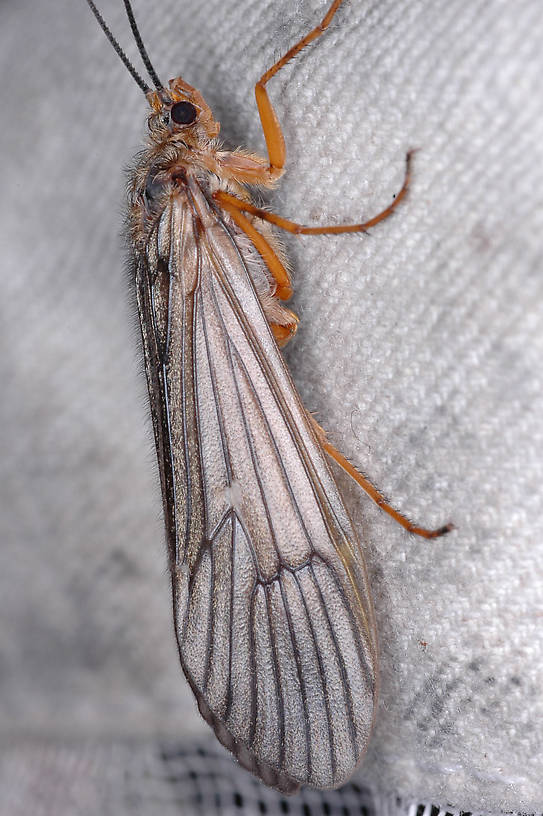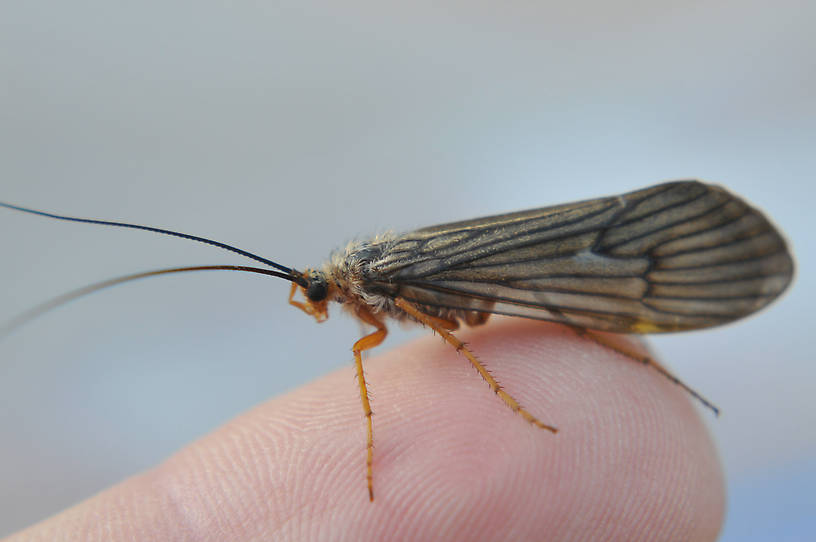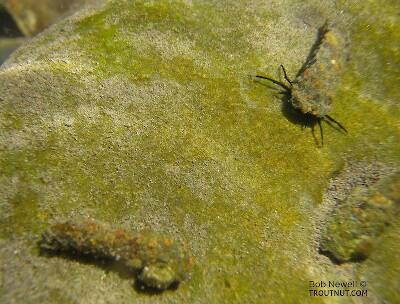
Salmonflies
Pteronarcys californica
The giant Salmonflies of the Western mountains are legendary for their proclivity to elicit consistent dry-fly action and ferocious strikes.
Featured on the forum

This is an interesting one. Following the keys in Merritt R.W., Cummins, K.W., and Berg, M.B. (2019) and Jacobus et al. (2014), it keys clearly to Ephemerella. Jacobus et al provide a key to species, but some of the characteristics are tricky to interpret without illustrations. If I didn't make any mistakes, this one keys to Ephemerella mucronata, which has not previously been reported any closer to here than Montana and Alberta. The main character seems to fit well: "Abdominal terga with prominent, paired, subparallel, spiculate ridges." Several illustrations or descriptions of this holarctic species from the US and Europe seem to match, including the body length, tarsal claws and denticles, labial palp, and gill shapes. These sources include including Richard Allen's original description of this species in North America under the now-defunct name E. moffatae in Allen RK (1977) and the figures in this description of the species in Italy.

Troutnut is a project started in 2003 by salmonid ecologist Jason "Troutnut" Neuswanger to help anglers and
fly tyers unabashedly embrace the entomological side of the sport. Learn more about Troutnut or
support the project for an enhanced experience here.
Caddisfly Genus Dicosmoecus (October Caddisflies)
This is a superhatch in the West. Gary LaFontaine had a self-proclaimed obsession with Dicosmoecus, and he devotes several pages of Caddisflies to stressing the importance of its larvae, pupae, and adults. He wrote:
His reasons for this judgement are five traits of Dicosmoecus:
Personally I have only caught a good Dicosmoecus hatch one time, and on a secret desert spring creek. It reminded me of fishing Isonychia mayfly hatches back east, because there weren't enough bugs around to have trout rising consistently, but the presence of a particularly good food source in low numbers for a long time had them on the lookout for imitations. I had big trout cartwheeling out of the water to smash actively-fished imitations.
The question for fly fishermen seeking big trout is: "Which insects provide the best opportunity for catching such fish?" My list would be: Giant Orange Sedge (Dicosmoecus sp.), Salmon Fly (Pteronarcys californica, a stonefly), and the Michigan Mayfly (Hexagenia limbata). Dicosmoecus is the most important -- and the contest is not even close.
His reasons for this judgement are five traits of Dicosmoecus:
- Very large size: Adults 30mm long, and thick.
- Activity concentrated within 2-3 weeks.
- Emerges in the low, clear water of fall.
- Active during afternoon and evening.
- Abundant in rivers with sea-run trout.
Personally I have only caught a good Dicosmoecus hatch one time, and on a secret desert spring creek. It reminded me of fishing Isonychia mayfly hatches back east, because there weren't enough bugs around to have trout rising consistently, but the presence of a particularly good food source in low numbers for a long time had them on the lookout for imitations. I had big trout cartwheeling out of the water to smash actively-fished imitations.
Where & when
See the species pages for details about distribution and emergence times.In 67 records from GBIF, adults of this genus have mostly been collected during September (34%), August (28%), October (25%), and July (6%).
In 45 records from GBIF, this genus has been collected at elevations ranging from 16 to 20669 ft, with an average (median) of 6781 ft.
Genus Range
Hatching behavior
Emerging Dicosmoecus pupae may be the least important stage of the hatch. They will crawl out onto rocks to emerge when ideal rocks are nearby, but otherwise they emerge on the surface. Either behavior is likely to take place in water too shallow for trout to comfortably feed. The minority of the pupae emerging in deeper water are probably still prolific enough, at times, to excite the trout.Egg-Laying behavior
Time of day: Late afternoon through nightfall, peaking at sunset
Larva & pupa biology
The larvae are unusually prone to behavioral drift during the daytime in June and July, usually around 4:00 p.m. They may be in between cases when they do this, making them especially appealing and visible to hungry trout.
In mid- to late summer they enter diapause until cooler fall temperatures trigger them to pupate in a synchronized way.
Identification
Anglers on the lookout for large, orange-bodied "October Caddis" should keep in mind that Dicosmoecus isn't the only one to fit that description. The related Onocosmoecus can be easily mistaken for them.Dicosmoecus Fly Fishing Tips
These large insects make plenty of commotion on the water while egg-laying, and fishing an imitation with motion may draw ravenous strikes from otherwise-inactive midday trout.Specimens of the Caddisfly Genus Dicosmoecus
2 Female Adults
2 Adults
1 Underwater Picture of Dicosmoecus Caddisflies:
Discussions of Dicosmoecus
october caddis
Posted by Amosg on Oct 6, 2011
Last reply on Oct 6, 2011 by Amosg
In Alberta they exist in very small numbers but are not important to fishermen--Amos
You Western anglers - any experience with the Giant Orange Sedges?
7 replies
Posted by Troutnut on Jul 29, 2006
Last reply on Jan 7, 2009 by Dgracia
This seems to be a very important insect for which I have no experience and few sources. I want to be sure that my writeup is accurate and fairly complete. Do any of you who fish out west know any details I've left out?
October Caddis
19 replies
Posted by Taxon on Jul 29, 2006
Last reply on Oct 24, 2008 by Jack_k
Jason-
In the Pacific NW, Dicosmoecus are generally referred to as either October Caddis or Fall Caddis. The field guide I generally recommend for western fly fishers is Hatch Guide For Western Streams by Jim Schollmeyer. This is what he has to say about Dicosmoecus pupae, and I believe it clarifies any ambiguity of the passage you quoted from Caddisflies:
In the Pacific NW, Dicosmoecus are generally referred to as either October Caddis or Fall Caddis. The field guide I generally recommend for western fly fishers is Hatch Guide For Western Streams by Jim Schollmeyer. This is what he has to say about Dicosmoecus pupae, and I believe it clarifies any ambiguity of the passage you quoted from Caddisflies:
In the early or mid summer, the larvae reach maturity and move from the faster currents to the slower flows that are generally found along the margins of the stream. Then they attach their cases to the rocks, seal themselves inside, and begin pupation. This transformation takes about two months. When the pupae are ready to emerge anytime between late afternoon and dark, they chew open the front of their cases and swim or crawl to the surface. The ones that find exposed rocks cling to them close to or just above the waterline; their pupal shucks split open and the adults emerge. Larvae that took refuge and pupated behind unexposed mid-stream rocks pupate and emerge in the open water. Most pupae emerge from waters that are too shallow or too exposed for trout. Any pupae that emerge in deep or open waters are vulnerable as they swim to shore or the surface.
A good Dicosmoecus discussion
1 replies
Posted by Troutnut on Aug 22, 2006
Last reply on Aug 22, 2006 by Taxon
There's a good topic with people sharing their experiences with Dicosmoecus over at the Washington Fly Fishing Forum.
Start a Discussion of Dicosmoecus
References
- Jacobus, L. M., Wiersema, N.A., and Webb, J.M. 2014. Identification of Far Northern and Western North American Mayfly Larvae (Insecta: Ephemeroptera), North of Mexico; Version 2. Joint Aquatic Science meeting, Portland, OR. Unpublished workshop manual. 1-176.
- LaFontaine, Gary. 1981. Caddisflies. The Lyons Press.
- Merritt R.W., Cummins, K.W., and Berg, M.B. 2019. An Introduction to the Aquatic Insects of North America (Fifth Edition). Kendall/Hunt Publishing Company.
- Swisher, Doug and Carl Richards. 2000. Selective Trout. The Lyons Press.
Caddisfly Genus Dicosmoecus (October Caddisflies)
Taxonomy
Species in Dicosmoecus: Dicosmoecus atripes, Dicosmoecus gilvipes
2 species (Dicosmoecus obscuripennis and Dicosmoecus pallicornis) aren't included.


